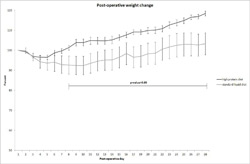|
Back to 2014 Annual Meeting Posters
High Protein Diet (HPD) Improves Post-Operative Weight Gain After Massive Small Bowel Resection
Raphael C. Sun*, Pamela M. Choi, Jose Diaz-Miron, Josh Sommovilla, Jun Guo, Christopher R. Erwin, Brad Warner
Department of Surgery, Washington University in St. Louis, St Louis, MO
Background
Short bowel syndrome (SBS) is a morbid clinical condition that results from massive small bowel resection. Many SBS patients require long term parenteral nutrition (PN) which carries a high complication rate. After small bowel resection (SBR), there is a dramatic weight loss in the acute post-operative period. Simultaneously, structural adaptation occurs to compensate for the loss of function and absorption of nutrients. Although we have previously found that a high fat diet enhances intestinal villus growth and weight gain after SBR, the effects of augmented protein diet on resection-associated metabolic responses is presently unknown. The purpose of this study is to determine weight gain and body composition changes after SBR using a high protein diet.
Methods
C57BL/6 mice underwent 50% proximal SBR. Post-operatively, mice were randomly selected to receive standard rodent liquid diet (LD) (n=6) or an isocaloric high protein diet (HPD) (n=9) for 28 days. LD consisted of 17% protein versus HPD consisted of 45% protein while the percentage of fat content remained the same in both diets. Both diets were based on the Lieber-Decarli formula to produce an isocaloric proportion of 1 kcal per gram. Mice weights were recorded daily. Food intake and fecal output were compared between the two groups. Body composition percentages were obtained at POD 0, 7, 14, 21, and 28 days. Structural intestinal adaptation between mice receiving LD versus HPD was also measured. Student t-test was used for statistical comparisons between groups with p<0.05 defined as significant.
Results
Mice that were fed HPD after small bowel resection returned to baseline weight (measured after resection) on an average of post-operative day (POD) 8 versus mice that were fed LD returned to baseline weight on average of POD 22. (Figure 1) There was no statistical difference in daily food intake (p-value =0.99) and fecal output (p-value =0.33) between the LD and HPD groups. Total fat mass and lean mass were significantly different by POD 14 between mice in the LD versus HPD group. However, the percentages of fat mass and lean mass increased at a similar rate within each group throughout the post-operative period in both groups of mice. (Figure 2) Despite the difference in weight gain between LD and HPD, the post-operative histology of the small intestine showed no differences in the degree of adaptation for both crypt depth (p-value=0.19) and villus height (p-value=0.68).
Conclusion
HPD results in greater weight gain in mice after SBR. This finding may be clinically important for patients with SBS since better weight gain may reduce the time needed for PN.
 Post-operative weight gain after proximal small bowel resection between mice fed standard liquid diet versus high protein diet  Post-operative body composition after small bowel resection between mice fed standard liquid diet versus high protein diet
Back to 2014 Annual Meeting Posters
|



